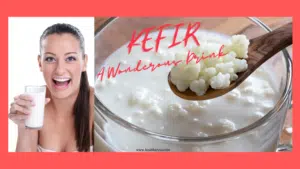Here is a secret to traditional Rice Kanji, also known as fermented rice water or fermented rice bran with several benefits as one of the homemade probiotic rice. How to make fermented rice water?
Digestive Issues, Probiotics & Fermented Foods
Digestive issues are one of the most common problems affecting many individuals. The gut microbiome plays a crucial role to improve or destroy our health. Good gut health is the balance between helpful & potentially harmful bacteria in our digestive system. The start, management, and prevention of numerous gastrointestinal illnesses can often be significantly influenced by dietary practices and particular food types. There are several ways to improve your gut health & one of them is by consuming probiotics.
Probiotics are types of living-friendly micro-organisms like those that are found in our digestive tract. They are naturally found in fermented foods & can also be taken as a supplement. Characteristics of fermented food are that they are stored for a particular time, have a distinctive smell, and flavor, and have several health benefits associated with them.
Research shows that traditional recipes helped with better gut flora. Several probiotics such as curd, buttermilk, yogurt, idli, dosa, kombucha, kefir, soy temph, fermented veggies, and many more are found in cuisines worldwide. Simple processes like fermentation will help improve nutritional quality & should be encouraged to combat malnutrition.
Let us talk about one of the homemade probiotic rice, Rice Kanji, also known as fermented rice bran/water, and learn how to make fermented rice water.
Rice Kanji/ Fermented Rice Water/ Fermented Rice Bran – One of the Traditional Homemade Probiotic Rice
Curd and buttermilk are sometimes not well tolerated by lactose-intolerant individuals & not used by vegans, so here we shall discuss traditional rice kanji, also called fermented rice water or fermented rice bran, one of the homemade probiotics. Rice kanji is the water left after making rice or soaking rice in it.
Panta Bhat is consumed mostly in East India. In Bengali New Year, fermented rice with fish is a must. This traditional practice is continued in Tamil Nadu & Kerala too. Fermenting the leftover cooked rice is eco-friendly, and cost-effective & also helps reduce waste along with improving the nutritional quality.
Cooked rice is kept overnight to ferment in an earthen pot. Rice water is rich in starch but fermentation improves the nutritional quality of rice bran. Post-fermentation, rice gets enriched with antioxidants, antimicrobial properties, and metabolites like phenolics, flavones, vitamin E, phytosterol, anthocyanin, linoleic acid, etc.
Rice Kanji/ Probiotic Rice Benefits Owing to Changes in the composition of Fermented Rice Water or Fermented Rice Bran
Rice bran is the outer layer of rice. After fermentation, there are several advantages and enhancements in the nutritional quality of fermented rice water or rice bran kanji such as the following:
- Rice kanji or fermented rice water is easy to digest
- A 20% reduction in saturated fatty acids in rice bran kanji, but no significant alteration in linoleic, oleic, and palmitic acids
- Protein quality improves after the fermentation of rice water or rice bran, and it becomes more bioavailable.
- Fermentation enhances the total phenolic compounds and free radical scavenging (antioxidant) properties in rice water or bran.
- Anti-nutritional factors such as lecithin & trypsin inhibitors are reduced and thus the availability & absorption of micronutrients is improved in rice kanji.
Fermented Rice Kanji/ Probiotic Rice - Functional Changes
Food that has undergone fermentation aids in preserving the gut’s beneficial microbiota, which is necessary for the host’s physiological equilibrium and defense against a variety of disorders. Fermented rice water or bran or probiotic rice kanji has several health-promoting properties such as anti-diabetic, chemoprotective, anti‑atherogenic, hepatoprotective, anti-bacterial, and anti-fatigue.
A study conducted on mice reported that there was less dysbiosis of the microbiota and more Lactobacilli and Bifidobacteria, which are helpful bacteria, in those consuming the Fermented Rice extract. Fermented Rice Bran supplementation was reported to increase collagen synthesis and hence considered to have anti-aging properties. It can also protect against UV-B-mediated skin damage.
In addition to increasing the number of vital amino acids, vitamins, and minerals in the meal, fermentation also improves the food’s overall quality, digestibility, flavor, and aroma.
To use Rice Bran as a functional ingredient and to create unique, functional foods that can extend a healthy life, fermentation can definitely enhance the functional qualities of Rice bran.
Fermented Rice Kanji/ Probiotic Rice - Sensory changes
The color, aroma, texture & taste of rice change after fermentation. So, there are sensory changes.
Food safety and Shelf-life of Fermented Rice Bran/ Water or Rice Kanji or Probiotic Rice
Let us now know the safety of fermented rice bran, one of the homemade probiotics.
Numerous metabolites produced by nutritional characteristics frequently stop the establishment of spoilage and/or pathogenic bacteria. These metabolites include organic acids like lactic, propionic, and acetic acids, among others, that lower the initial pH value, provide an acidic environment in the food matrix, and lengthen the shelf-life of fermented goods.
Consumption of traditional fermented cereal products in Africa reduced diarrhea outbreaks in children by 40% and improved well-being.
Probiotic Rice Kanji or Fermented Rice Water Boosts Immunity
Probiotics help boost innate immunity, and so with homemade probiotic rice, but research is still needed on the strains required and the role of fermented rice water or Rice Kanji.
Health Benefits of Probiotic Rice Kanji or Fermented Rice Water/ Bran
Probiotics are said to have a wide range of health advantages, some of which include better immunity, improved digestion, and protection against diabetes and cancer. The microbial strain is anticipated to display specific desirable properties, such as acid and bile tolerance, antibacterial activity, adherence to the intestinal epithelium, etc. to function as an efficient probiotic.
Torani kanji
(fermented rice water curry with veggies)
Torani Kanji is a home remedy for better immunity & management of diarrhea. It also helps prevent constipation & dehydration.
Zutho
Zutho is a traditional rice beverage and fermented drink, that originated in Nagaland, India is known to boost the immune system, lower blood insulin levels, prevent loss of appetite, lower bad cholesterol, assist in wound healing, and prevent infection.
How to make fermented rice water? Recipe for Probiotic Rice Kanji
It is easy to make homemade probiotics and here is the recipe for this fermented rice bran or so-called Probiotic Rice Kanji.
Cooked white rice- 3 tbsp
Water- ½ cup
Mustard seeds- 1 tsp
Oil- 0.5 tsp
Coriander leaves- 2 tsp chopped
Asafoetida- ¼ tsp
Curry leaves- 2 chopped
Salt- to taste
Method
In an earthen pot, take cooked white rice, add a little water & allow it to ferment overnight. In a pan, heat oil, add mustard seeds & allow them to crackle. Then add curry leaves, asafoetida & fermented rice with a little water. Add salt & sauté. Add chopped coriander leaves & serve.
How to make Cool Cucumber Fermented Rice Water? Another Rice Kanji Recipe
Another recipe for homemade probiotics includes cool cucumber fermented rice water.
Cooked white rice- ½ cup
Water- ½ cup
Urad dal- 1 tsp
Grated cucumber- ½ no.
Curry leaves- 2 chopped
Salt- to taste
Oil- 0.5 tsp
Coriander leaves- 2 tsp chopped
Lactose-free curd/ yogurt/ curd- 2 tbsp
Method
In an earthen pot take cooked white rice, add a little water & allow it to ferment overnight. In a pan heat oil, add mustard seeds & allow them to crackle, add urad dal add curry leaves.
Rice kanji can also be consumed on an empty stomach. One can add salt & pepper to taste.
References
- Cde, K. R. L. (2017). Krause’s Food & the Nutrition Care Process(15th ed.). Saunders.
- Sahoo, Lenka, Biswal. (2017) Knowledge and Awareness about Health Benefits of indigenous fermented foods: A comprehensive study. International Journal of Food Science and Nutrition.
- Chakraborty, S. (2021, October 16). Rise to the fermented wonder!Deccan Herald. https://www.deccanherald.com/sunday-herald/sunday-herald-melange/rise-to-the-fermented-wonder-1040677.html
- Sivamaruthi, B., Kesika, P., & Chaiyasut, C. (2018). A comprehensive review on functional properties of fermented rice bran. Pharmacognosy Reviews, 12(24), 218. https://doi.org/10.4103/phrev.phrev_11_18
- Oh, W. S., Jung, J. C., Choi, Y. M., Mun, J. Y., Ku, S. K., & Song, C. H. (2020). Protective effects of fermented rice extract on ulcerative colitis induced by dextran sodium sulfate in mice. Food science & nutrition, 8(3), 1718–1728. https://doi.org/10.1002/fsn3.1460
- Tsafrakidou, P., Michaelidou, A. M., & G. Biliaderis, C. (2020, June 3). Fermented Cereal-based Products: Nutritional Aspects, Possible Impact on Gut Microbiota and Health Implications. Foods, 9(6), 734. https://doi.org/10.3390/foods9060734
- Maheshwari, M., Gupta, A., & Gaur, S. (2020, July 14). Probiotic Potential of Traditional Indian Fermented Drinks. Current Nutrition &Amp; Food Science, 16(5), 638–643. https://doi.org/10.2174/1573401315666190821113406
- Ray, M., Ghosh, K., Singh, S., & Chandra Mondal, K. (2016). Folk to functional: An explorative overview of rice-based fermented foods and beverages in India. Journal of Ethnic Foods, 3(1), 5–18. https://doi.org/10.1016/j.jef.2016.02.002
- Ardiansyah, Nada, A., Rahmawati, N. T. I., Oktriani, A., David, W., Astuti, R. M., Handoko, D. D., Kusbiantoro, B., Budijanto, S., & Shirakawa, H. (2021). Volatile Compounds, Sensory Profile and Phenolic Compounds in Fermented Rice Bran. Plants (Basel, Switzerland), 10(6), 1073. https://doi.org/10.3390/plants10061073

Shailee Sanghavi M.Sc.
Related Posts


Multivitamin, Probiotic, Omega 3 – Don’t Let Dietary Supplement Selection Overwhelm You

Symptoms of SIBO vs IBS, hydrogen vs methane SIBO symptoms and Hydrogen sulfide SIBO




